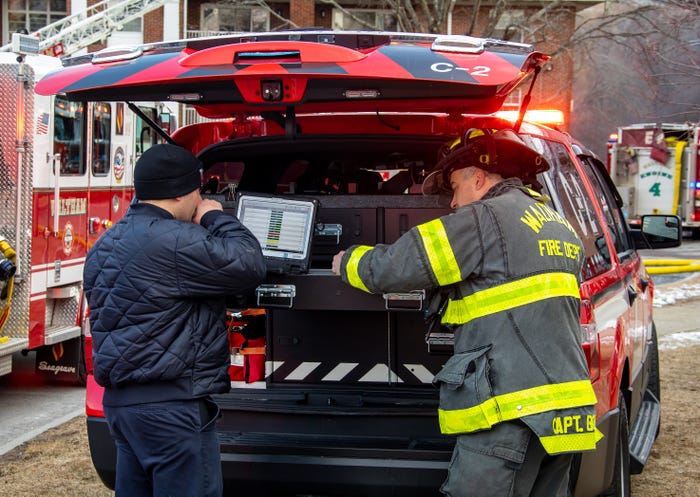High-power user equipment (HPUE) can help bridge Band 14 coverage gaps in rural, in-building locations
.jpg?width=1280&auto=webp&quality=95&format=jpg&disable=upscale)
High-power user equipment (HPUE) can improve the range, throughput and resilience of LTE signals on 700 MHz Band 14 in the U.S., and HPUE products are expected to be available later this year, an official for Assured Wireless said during a conference session at IWCE 2019 in Las Vegas.
While public safety is intrigued by the performance capabilities of the FirstNet system being built by AT&T, first-responder representatives repeatedly have expressed concern that typical LTE devices use only 0.200-0.250 watts of power when transmitting signals. By using HPUE—a 3GPP standard that can be used only on the 700 MHz Band 14 spectrum licensed to FirstNet in the U.S.—devices can transmit signals at 1.25 watts of power, according to Bob LaRose, vice president of business development at HPUE maker Assured Wireless.
“With HPUE, … that really increases the range by nearly 80%,” LaRose said during his session presentation on the final conference day of IWCE 2019. “When you look at your old geometry textbooks … you take it around the circle, that’s nearly triple the total coverage area—and that’s without any modifications to the infrastructure.
“That’s looking at the range. The other benefit to the urban user is that it [an HPUE signal] gets into basements and elevators—places where you get disconnected with your current cell-phone devices operating on low power. This is what gives you that deep penetration inside of buildings, parking garages and places like that.”
During the past year, AT&T officials have expressed optimism about the coverage improvements that could be realized by deploying HPUE and have indicated an intention to introduce HPUE devices to the marketplace this year. LaRose confirmed that timeline.
“AT&T is very anxious to implement HPUE to further their FirstNet footprint as quickly as possible,” LaRose said. “This year is the year that they will implement HPUE, and it’s going to give them a tremendous boost in their coverage.”
“For FirstNet, this helps AT&T with the buildout. On the fringe of coverage—that percentage of the country that’s hard to cover—it will give them more penetration in that range. In urban environments, the in-building and underground coverage is increased. And, for everyone, it means much faster data throughput and network capacity.”
With a more robust signal operating at a higher power level, HPUE devices do not need to resend packets as often as a typical LTE device and can enjoy the benefits of using higher-level modulation schemes that support greater data-throughput, according to LaRose. This results in the user experiencing the benefits of better data speeds, particularly when using the device to uplink video or other high-bandwidth data, he said.
All of these HPUE performance characteristics are important to FirstNet and AT&T. Today, Verizon is the market leader in public-safety broadband, and its representatives repeatedly tout that Verizon’s LTE network coverage exceeds the coverage provided by AT&T by more than 400,000 square miles nationwide. Deploying HPUE across the AT&T system would greatly expand the FirstNet coverage area and potentially address existing coverage holes in urban and suburban locations.
To help address this goal, Assured Wireless is revamping its business plan, postponing its plans to develop an HPUE gateway with edge-computing capability, LaRose said. Instead, Assured Wireless is developing a high-power module that can be integrated with existing mobile-router solutions, he said.
“We have to come up with an approved device—it’s going to be a module, in our case—to work with the various OEMs that are doing mobile routers right now,” LaRose said. “It is our fondest hope that some manufacturers will have HPUE in their devices at APCO [the APCO 2019 event in August].”
AT&T will not need to make physical alterations to its cell sites to support HPUE operations on the FirstNet system, but the carrier will need to upgrade its network software to LTE Release 13 standards and to identify HPUE devices on the network and their capabilities, LaRose said.
“Just as important, the algorithms in their software need to be changed, so that the handoffs happen properly between one cell to another,” he said.
3GPP—the standards body the oversees LTE technology—requires that HPUE not create any more interference than a normal LTE device and conducted “a very extensive study” to ensure that this is possible, LaRose said.
Although HPUE transmits at much greater power than a typical LTE device, the HPUE standard does not allow the 3-watt and 5-watt maximum power levels allowed in LMR, LaRose said.
“I’m saying closer [to LMR power levels], not to parity,” he said.
Currently, Assured Wireless is focused on HPUE solutions for in-vehicle mobile scenarios, although it is developing a body-worn product that is an antenna that is designed specifically to reduce the user’s potential exposure to the higher-power wireless signal, LaRose said.
When asked about the potential for an HPUE smartphone, LaRose said, “We’re not ruling that out, but that’s a whole other magnitude of complexity and miniaturization.”
One big issue for a smartphone will be meeting the FCC rules for signal absorption rate (SAR) on a high-power device that a user could hold next to his/her head, LaRose said. That is not a problem for the in-vehicle use case, as the maximum HPUE power is just a fraction of the power used in a typical LMR mobile system, he said.





